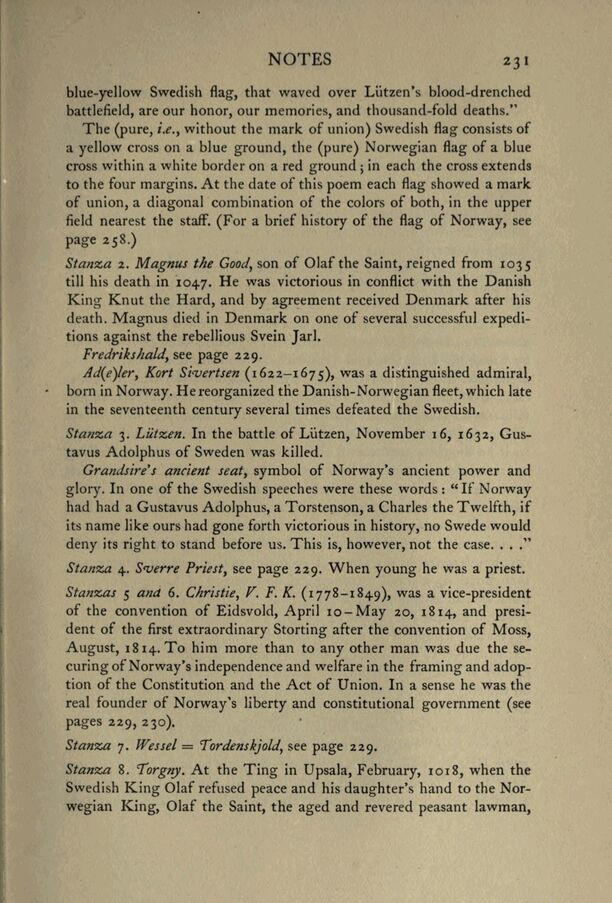
Full resolution (JPEG) - On this page / på denna sida - Sidor ...

<< prev. page << föreg. sida << >> nästa sida >> next page >>
Below is the raw OCR text
from the above scanned image.
Do you see an error? Proofread the page now!
Här nedan syns maskintolkade texten från faksimilbilden ovan.
Ser du något fel? Korrekturläs sidan nu!
This page has never been proofread. / Denna sida har aldrig korrekturlästs.
NOTES 231
blue-yellow Swedish flag, that waved over Liitzen’s blood-drenched
battlefield, are our honor, our memories, and thousand-fold deaths.”
The (pure, i.e., without the mark of union) Swedish flag consists of
a yellow cross on a blue ground, the (pure) Norwegian flag of a blue
cross within a white border on a red ground; in each the cross extends
to the four margins. At the date of this poem each flag showed a mark
of union, a diagonal combination of the colors of both, in the upper
field nearest the staff. (For a brief history of the flag of Norway, see
page 258.)
Stanza 2. Magnus the Good, son of Olaf the Saint, reigned from 1035
till his death in 1047. He was victorious in conflict with the Danish
King Knut the Hard, and by agreement received Denmark after his
death. Magnus died in Denmark on one of several successful expedi-
tions against the rebellious Svein Jarl.
Fredrikshald, see page 229.
Ad(eyler, Kort Sivertsen (1622-1675), was a distinguished admiral,
born in Norway. He reorganized the Danish-Norwegian fleet, which late
in the seventeenth century several times defeated the Swedish.
Stanza 3. Liitzen. In the battle of Liitzen, November 16, 1632, Gus-
tavus Adolphus of Sweden was killed.
Grandsire’s ancient seat, symbol of Norway’s ancient power and
glory. In one of the Swedish speeches were these words: “If Norway
had had a Gustavus Adolphus, a Torstenson, a Charles the Twelfth, if
its name like ours had gone forth victorious in history, no Swede would
deny its right to stand before us. This is, however, not the case... .”
Stanza 4. Sverre Priest, see page 229. When young he was a priest.
Stanzas 5 and 6. Christie, V. F. K. (1778-1849), was a vice-president
of the convention of Eidsvold, April 1o—May 20, 1814, and presi-
dent of the first extraordinary Storting after the convention of Moss,
August, 1814. To him more than to any other man was due the se-
curing of Norway’s independence and welfare in the framing and adop-
tion of the Constitution and the Act of Union. In a sense he was the
real founder of Norway’s liberty and constitutional government (see
pages 229, 230).
Stanza 7. Wessel = Tordenskjold, see page 229.
Stanza 8. Torgny. At the Ting in Upsala, February, 1018, when the
Swedish King Olaf refused peace and his daughter’s hand to the Nor-
wegian King, Olaf the Saint, the aged and revered peasant lawman,
<< prev. page << föreg. sida << >> nästa sida >> next page >>